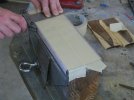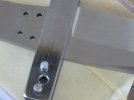- Joined
- Apr 2, 2011
- Messages
- 425
Well I got my craftsman 2x42 and am waiting on my belts ( Canada Post strike) and to move out of the condo so I can use it . I got a piece of CPM S35VN 1/8 x 2' about 9 inches long that I've descaled and sanded flat. I've only made 2 knives before both Loveless style drop points ( I hate attaching that name to the monstrosities I made). I want to make a knife for a friend I served with in Afghanistan who is back there . I was initially thinking of making something similar to the ZT 0121 , but less fancy now I'm second guessing that type of design. It will be mainly used as a utility/edc knife to be used and abused.
I'm not asking for someone to make me a design , just a little push in the right direction of what a very beginner should try to make for this situation. Examples are welcome, I have the L Harding templates and a bunch of knife making books, loveless,etc. Here is pics of my last knife I just finished waiting for HT to show my skill level or lack thereof .


Thanks
I'm not asking for someone to make me a design , just a little push in the right direction of what a very beginner should try to make for this situation. Examples are welcome, I have the L Harding templates and a bunch of knife making books, loveless,etc. Here is pics of my last knife I just finished waiting for HT to show my skill level or lack thereof .


Thanks
Last edited:








